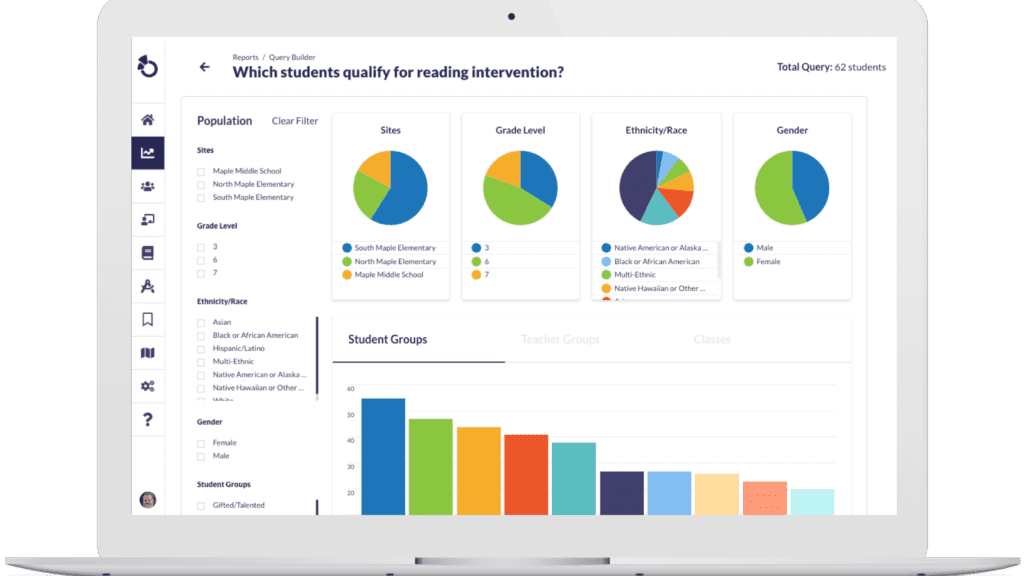A recent Pew Research Center study found that 25% of U.S. teachers say AI tools in K-12 education do more harm than good. Another 32% say it’s a mix of both, while just 6% believe the benefits outweigh the drawbacks.
Just six percent.
With numbers like this, it’s fair to ask: what’s really working when it comes to AI in schools?
In 2025, AI is part of the everyday reality in K-12 classrooms. Teachers use it to generate quiz questions or grade them. Administrators use it to analyze data and spot districtwide trends. Students are turning to AI for quick feedback, extra practice, and even tutoring help when they get stuck.
Yet, despite its growing presence, uncertainty remains. Educators are rightfully cautious about how AI shapes instruction, student privacy, and professional judgment. The potential is enormous, but so are the risks if schools move too quickly or without clear purpose.
So, what are the real pros and cons of AI in K-12 education? Let’s take a closer look at both sides of the story and how schools can make thoughtful, student-centered choices along the way.
The pros: How AI is helping schools
AI has sparked plenty of debate, but many educators agree on one thing: when used thoughtfully, it can make their jobs easier and their instruction more targeted. A recent EdTech Magazine survey found that 42% of teachers say AI reduces time spent on administrative tasks, while others report gains in personalization and engagement. Here are a few areas where schools are seeing meaningful impact.
Personalization without the burnout
AI gives teachers a clearer picture of what each student needs and when they need it. Instead of relying on broad test scores, educators can use AI-powered tools to identify gaps, suggest next steps, and tailor lessons to student strengths and areas of opportunity. When done right, this makes differentiation more sustainable and helps students take ownership of their progress.
For instance, educators can use Otus’ AI-driven insights to surface trends across assessment, attendance, and behavior, helping identify who needs enrichment or additional support before issues grow.
Gaining back hours each week
Ask any teacher, and they’ll tell you time is their most valuable resource. AI can take some of the routine tasks off their plate, from generating quiz questions to summarizing assessment results. That same EdTech Magazine survey found that nearly half of educators say AI has made them more efficient, allowing them to focus on lesson design, feedback, and meaningful student interaction.
Tools like Otus’ AI question generator, for example, help teachers build assessments faster, while built-in analytics simplify grading and reporting, saving hours every week.
Trading data overload for easy insights
Perhaps the biggest perk of AI is its ability to turn large amounts of data into something educators can actually use. Instead of digging through spreadsheets, teachers and administrators can view clear visualizations that highlight student growth and trends over time. This helps districts shift from reactive to proactive decision-making.
Take Otus, for instance, which brings assessment and performance data together in one view, using AI to identify patterns that can guide intervention planning, MTSS support, and PLC discussions.
Giving access to each and every learner
For students who need different entry points to learning, AI can make instruction more accessible. Test-to-speech, translation, and adaptive feedback tools give all learners a fair chance to engage and succeed. Used thoughtfully, these supports can reinforce teacher guidance in a significant way.
The cons: Where AI can go wrong
Even with its potential, AI isn’t a guaranteed win for schools (nor is it a “layup”). Teachers’ hesitations are grounded in real concerns, from data privacy to algorithmic bias to widening inequities in districts. These challenges certainly don’t mean AI should be avoided altogether, but they do highlight the importance of thoughtful planning and transparency.
When “smart” tools risk student privacy
Student data is what drives every AI tool, and that’s precisely where much of the worry begins. The U.S. Department of Education’s “Artificial Intelligence and the Future of Teaching and Learning” report warns that AI systems in schools can introduce “new risks to student privacy, safety, and security” if not governed properly. Understandably, many educators simply don’t feel equipped to evaluate those risks.
That’s precisely why vetting AI tools for compliance and clear data governance is essential before use in classrooms. For example, Otus was built with safeguards in mind, maintaining strict FERPA compliance and ensuring districts maintain full ownership of their data.
The equity dilemma
While AI can open doors, it can also leave some students standing outside. Districts with limited budgets or aging technology often struggle to adopt AI tools at the same pace as those with more resources. Inconsistent internet access for students, outdated devices, and staffing shortages can make implementation uneven from one school (or even one classroom) to the next.
These differences don’t just affect who uses AI. They can influence how effectively it’s used, how data is interpreted, and which students benefit the most. Without careful consideration, the very tools meant to create more personalized learning experiences could unintentionally deepen existing inequities.
For educators and leaders, that reality underscores why conversations about AI must include equity from the start. Access, training, and responsibility can’t be afterthoughts. They’re central to ensuring AI truly supports every learner.
Biased data, biased results
AI systems are only as objective as the data they’re trained on. A meta-analysis of 555 AI models found that 83% showed a high risk of bias in educational settings. That means algorithms can unintentionally amplify disparities, misinterpret student data, or overgeneralize patterns.
Educators can help offset this by using AI as a guide (or an “assistant”), not a decision-maker. Data should inform human judgment, not replace it. A solution like Otus keeps teachers in control, using AI to surface patterns and insights while leaving interpretation and action in human hands.
Losing the human touch
Sure, AI can simplify tasks, but it can’t replace relationships. The risk of overreliance is subtle: leaning on tools for lesson plans or assessments can inadvertently limit creativity and the human touch that makes teaching so powerful.
In other words, AI can save time, but it can’t understand context or care about a student’s story. That’s where educators make the difference and where balance becomes essential. Even the best algorithm can’t see the spark when a student finally “gets it,” sense frustration behind a quiet classroom, or adapt a lesson in real time to meet students’ needs. These are deeply human moments that technology can support, but never replicate.
Used wisely, AI should amplify teachers’ instincts, not replace them. The real opportunity lies in blending technology’s efficiency with educators’ empathy and insight, keeping people, not programs, at the center of learning.
Finding the right balance with AI
Striking the right balance with AI in education takes intention. The technology can enhance teaching in powerful ways, but only if it’s used to strengthen, not replace, the human connection at the heart of learning.
For district and school leaders, that means putting purpose before product. The most successful AI initiatives start with clear goals: improving equity, supporting teacher effectiveness, or making data more usable, just to name a few. When schools stay anchored in these goals, AI becomes a tool for growth and clarity.
That’s the approach behind Otus AI. By turning complex data into clear insights and keeping teachers in control, Otus empowers educators to take meaningful action that drives student growth.

The Otus Team
The Otus team is made up of former school leaders and educators with a combined total of over 200 years of experience. Together, we’re committed to giving educators the insights they need to support every student’s success.
Request a demo!
See exactly how Otus can help your school accelerate student growth and improve student outcomes – all while saving educators time.





